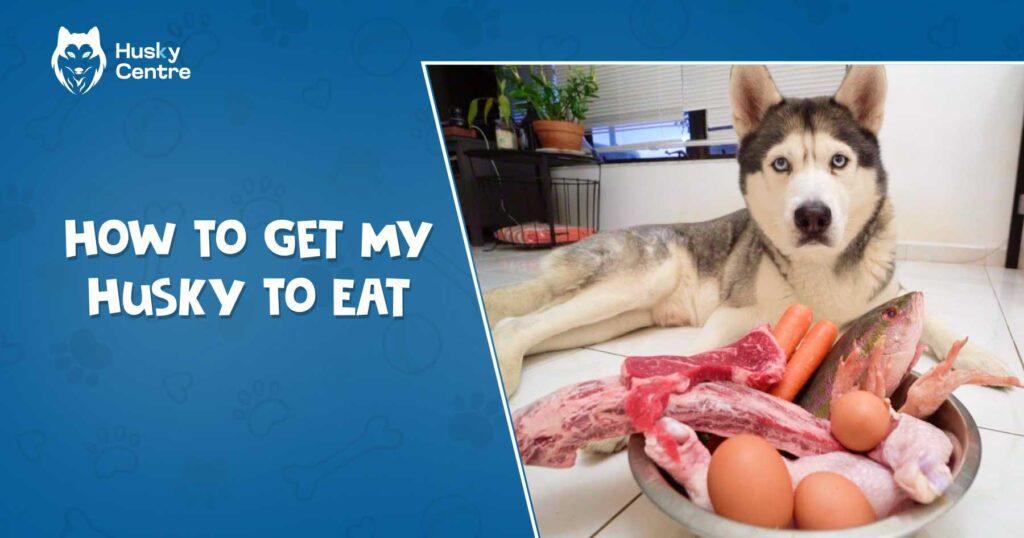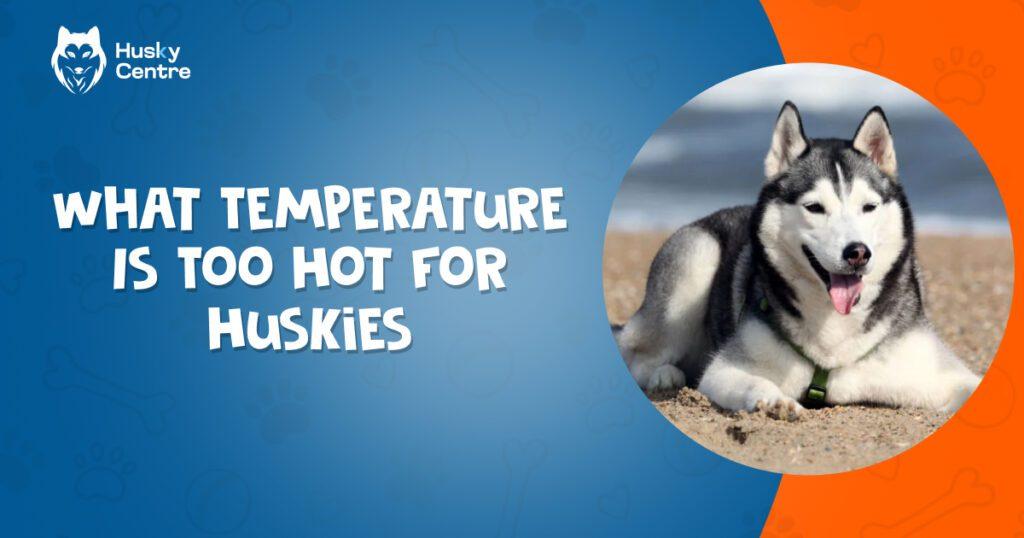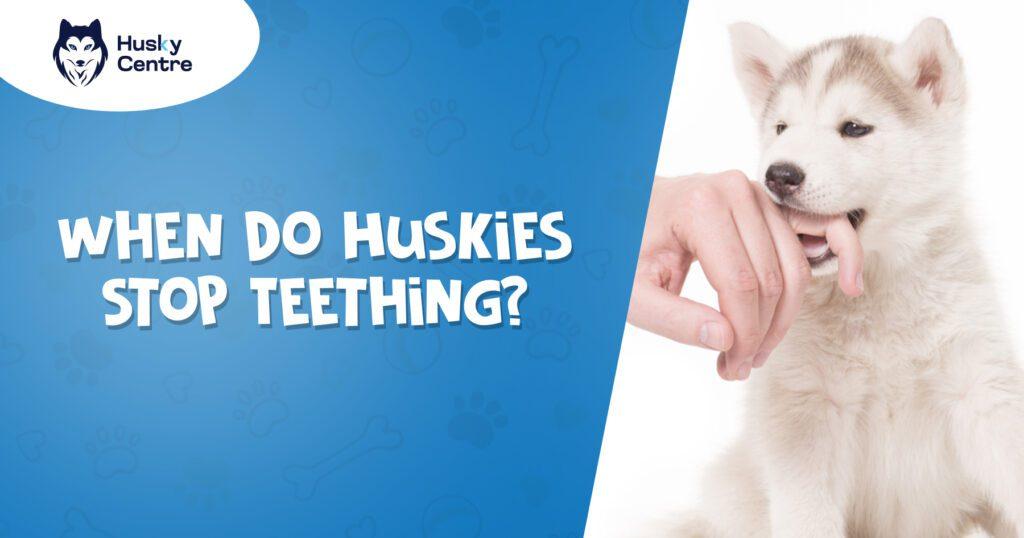To get your Husky to eat, establish a consistent feeding schedule and offer high-quality, palatable food. Ensure a calm eating environment free from distractions.
Huskies can be particular about their eating habits, making mealtime a challenge for many owners. A consistent feeding schedule helps set expectations and routines for your dog. Offering high-quality, palatable food ensures that your Husky receives the necessary nutrients and finds the food appealing.
Creating a calm eating environment free from distractions can also encourage your Husky to focus on their meal. Avoid giving too many treats or human food, as this can spoil their appetite for regular meals. Regular exercise can also help stimulate their appetite, ensuring they are ready to eat at mealtimes.
Huskies Eating Habits
If you have a Husky, you know they are unique in many ways, including their eating habits. Understanding Huskies Eating Habits is the key to ensuring your furry friend gets the nutrition they need. Let’s delve into their natural eating patterns, common reasons for picky eating, and important health considerations.
Natural Eating Patterns
Huskies have distinct eating patterns. Unlike some breeds, they don’t always eat their food immediately. Huskies often eat small portions throughout the day. This behavior is rooted in their ancestry as working dogs in harsh climates.
Key points about their natural eating patterns:
- Self-regulation: Huskies naturally regulate their food intake, eating only as much as they need.
- Activity-based appetite: Their appetite increases with higher activity levels and decreases when less active.
- Preference for variety: They can get bored with the same food and may prefer a varied diet.
To help you understand better, here’s a simple table:
| Pattern | Description |
| Self-regulation | Eat only as much as needed |
| Activity-based | Appetite tied to activity level |
| Variety preference | Enjoys different types of food |
Common Reasons For Picky Eating
Huskies can be picky eaters for various reasons. Understanding these can help you address the issue effectively. Stress and anxiety are common factors. Changes in the environment, new people, or unfamiliar situations can make them refuse food.
Here are some common reasons:
- Stress and anxiety: Environmental changes or new situations can affect their appetite.
- Food quality: Low-quality or unappealing food can lead to picky eating.
- Health issues: Dental problems or digestive issues might make eating uncomfortable.
- Feeding schedule: Irregular feeding times can disrupt their eating habits.
Creating a calm and consistent feeding environment can help. Offering high-quality, nutritious food also encourages better eating habits.
Health Considerations
Ensuring your Husky is healthy is crucial for their eating habits. Regular vet check-ups are essential to rule out any underlying health issues.
Here are some health considerations:
- Dental health: Regular dental checks can prevent issues that make eating painful.
- Digestive health: Ensure they have a balanced diet to avoid digestive problems.
- Weight management: Maintain a healthy weight to prevent obesity-related issues.
- Hydration: Ensure they have access to fresh water at all times.
A balanced diet tailored to their needs can improve their overall health and eating habits. Consulting with your vet for dietary recommendations can also be beneficial.
Assessing The Situation
Having trouble getting your Husky to eat? This can be a worrying experience for any dog owner. It’s important to address the root cause of your Husky’s lack of appetite. Start by assessing the situation to understand why your furry friend might be avoiding meals.
Check For Medical Issues
Your Husky’s eating habits can be influenced by underlying health problems. It’s crucial to rule out any medical issues first. Here are some steps to follow:
- Visit the Vet: Schedule an appointment with your veterinarian to conduct a thorough health check.
- Blood Tests: These can help identify any internal problems such as infections, liver or kidney issues.
- Dental Check: Painful teeth or gums can make eating difficult. Ask your vet to inspect your Husky’s mouth.
Keep an eye on these symptoms that might indicate a health issue:
| Symptom | Possible Issue |
| Vomiting | Gastrointestinal problems |
| Diarrhea | Infections or food intolerance |
| Weight Loss | Chronic diseases |
Ensuring your Husky is medically fit is the first step in solving their eating issues.
Observe Behavioral Changes
Behavioral changes can also affect your Husky’s eating habits. Observe your dog’s daily activities and interactions. Look for signs such as:
- Stress or Anxiety: New environments or changes in routine can make your Husky anxious.
- Lethargy: If your dog seems less active, it might be a sign of depression or boredom.
- Aggression: Sudden aggression can indicate discomfort or stress.
Here are some ways to address these behavioral changes:
- Regular Exercise: Huskies are active dogs. Ensure they get enough physical activity daily.
- Consistent Routine: Maintain a feeding and exercise schedule to provide stability.
- Interactive Toys: Use toys to keep your Husky engaged and mentally stimulated.
By understanding and addressing these behavioral changes, you can help improve your Husky’s appetite.
Evaluate Current Diet
Your Husky’s diet plays a significant role in their willingness to eat. Assess their current food to ensure it’s appropriate and appealing. Consider the following aspects:
- Food Quality: Ensure you’re providing high-quality, nutritious food.
- Food Type: Huskies can be picky. Experiment with wet, dry, and raw food to see which they prefer.
- Meal Portions: Adjust the portion sizes. Sometimes smaller, frequent meals work better.
Here is a sample comparison of different food types:
| Food Type | Pros | Cons |
| Dry Food | Convenient, long shelf life | Less moisture, can be less appealing |
| Wet Food | More moisture, often more palatable | Shorter shelf life, can be messy |
| Raw Food | Natural, high-protein | Requires careful handling, can be expensive |
Evaluating and adjusting your Husky’s diet can make a big difference in their eating habits.
Improving Your Husky’s Appetite
As a Husky owner, you might have faced challenges with getting your furry friend to eat. Huskies are known for their unique eating habits. Improving your Husky’s appetite can ensure they get the nutrition they need for a healthy, active life. Here are some tips to help you encourage your Husky to eat more regularly and with enthusiasm.
Choose The Right Food
Choosing the right food for your Husky is essential. Huskies can be picky eaters, and their dietary needs might differ from other dog breeds. Here are some tips to help you select the right food:
- High-Quality Ingredients: Ensure the food contains high-quality proteins like chicken, beef, or fish. Avoid foods with fillers or artificial additives.
- Balanced Diet: Look for a balanced diet that includes the right mix of proteins, fats, and carbohydrates.
- Grain-Free Options: Some Huskies may have grain allergies. Consider grain-free dog food if your Husky shows signs of allergies.
To help you choose, here’s a comparison table of some popular dog food brands:
| Brand | Protein Source | Grain-Free |
| Blue Buffalo | Chicken | Yes |
| Wellness Core | Turkey | Yes |
| Purina Pro Plan | Salmon | No |
Experiment with different brands and flavors to see which one your Husky prefers. Sometimes, adding a bit of wet food or broth to dry kibble can make the meal more appealing.
Maintain A Consistent Feeding Schedule
Maintaining a consistent feeding schedule helps regulate your Husky’s appetite. Dogs thrive on routine, and feeding them at the same times each day can encourage them to eat regularly. Follow these tips:
- Set Regular Meal Times: Feed your Husky twice a day, once in the morning and once in the evening.
- Limit Snacks: Avoid giving too many treats between meals. This can reduce their hunger during meal times.
- Monitor Portions: Ensure you are feeding the right amount of food based on your Husky’s weight and activity level.
Here’s a simple feeding schedule to follow:
| Time | Activity |
| 7:00 AM | Morning Meal |
| 12:00 PM | Short Walk |
| 6:00 PM | Evening Meal |
Sticking to this schedule can help your Husky develop a healthy eating routine and prevent them from skipping meals.
Create A Positive Feeding Environment
Creating a positive feeding environment can make meal times more enjoyable for your Husky. Here are some ways to do this:
- Quiet Area: Feed your Husky in a quiet area away from distractions and loud noises.
- Comfortable Space: Ensure the feeding area is comfortable and free from any stressors.
- Positive Reinforcement: Use positive reinforcement techniques like praise or petting when your Husky eats.
Sometimes, using interactive feeders or puzzle toys can make mealtime more engaging and fun for your Husky. Here’s a quick comparison of some popular options:
| Product | Type | Benefits |
| KONG Classic | Interactive Toy | Stimulates Mental Activity |
| Outward Hound Fun Feeder | Slow Feeder Bowl | Prevents Overeating |
| Trixie Activity Flip Board | Puzzle Toy | Encourages Problem Solving |
Making mealtime a positive experience can encourage your Husky to look forward to eating and help improve their overall appetite.
Techniques To Encourage Eating
Is your Husky being a picky eater? Getting your furry friend to eat can sometimes be a challenge. To help, we’ve compiled some effective techniques to encourage eating. These methods can make mealtime more appealing for your Husky.
Mix In Tasty Additions
Adding some tasty additions to your Husky’s food can make it more appealing. Think about what your Husky enjoys and incorporate those flavors. Here are some ideas:
- Broth: Add a splash of chicken or beef broth to their kibble.
- Wet Food: Mix a small amount of wet food with their dry kibble.
- Cooked Meat: Add some cooked, unseasoned meat like chicken or turkey.
- Vegetables: Incorporate some dog-friendly veggies like carrots or peas.
Here’s a table with some options:
| Ingredient | Amount | Notes |
| Chicken Broth | 1/4 cup | Ensure it’s low-sodium |
| Wet Food | 2 tbsp | Mix thoroughly |
| Cooked Meat | 1/4 cup | Unseasoned |
| Vegetables | 1/4 cup | Steamed or boiled |
Mixing in these tasty additions can make the food smell and taste better, encouraging your Husky to eat.
Warm Up The Food
Sometimes, simply warming up your Husky’s food can make a big difference. Warm food releases more aroma, making it more enticing. Follow these steps:
- Place the food in a microwave-safe bowl.
- Warm it in the microwave for about 10-15 seconds.
- Stir the food to ensure it heats evenly.
- Check the temperature to ensure it’s not too hot.
Heating food can enhance its smell, making it more appealing to your Husky. Be sure to:
- Test the temperature before serving to avoid burns.
- Use a microwave-safe bowl to prevent accidents.
- Warm the food just a little – it should be lukewarm, not hot.
Warming the food can make it more appetizing and encourage your Husky to eat more enthusiastically.
Hand-feeding And Interactive Toys
Hand-feeding your Husky can create a bond and make mealtime special. It can also help if your Husky is nervous or picky. Follow these tips:
- Start by offering small bites from your hand.
- Be patient and allow your Husky to eat at their own pace.
- Praise and reward them with treats or affection.
Interactive toys can also make eating fun and engaging. Consider these options:
- Food puzzles: Hide their food inside for a fun challenge.
- Kongs: Stuff their food inside to keep them entertained.
- Slow feeders: Encourage slower eating and mental stimulation.
Using hand-feeding and interactive toys can turn mealtime into an enjoyable activity for your Husky, making them more likely to eat willingly.
Behavioral Training And Reinforcement
Is your Husky being picky with food? Behavioral training and reinforcement can help your furry friend develop better eating habits.
By establishing mealtime rules, using positive reinforcement, and avoiding free-feeding, you can guide your Husky to eat more consistently and healthily.
Establish Mealtime Rules
Consistency is key to training your Husky. Establishing clear mealtime rules can create a structured environment that encourages better eating habits. Here are some rules to consider:
- Designate a feeding area: Choose a quiet, low-traffic area for feeding.
- Set specific meal times: Feed your Husky at the same times every day.
- Limit mealtime duration: Allow 20-30 minutes for eating, then remove the food.
Having a routine helps your Husky understand when to expect meals and reduces anxiety. This structure teaches them that food is not always available, which can motivate them to eat during designated times.
Use Positive Reinforcement
Positive reinforcement encourages good behavior by rewarding your Husky when they eat properly. This method is effective in motivating them to eat. Here are some techniques:
- Praise and petting: Offer verbal praise and gentle petting when your Husky starts eating.
- Treat rewards: Give a small treat after they finish their meal.
- Interactive feeding: Use puzzle feeders or treat-dispensing toys to make mealtime fun.
Reinforcing positive behavior helps your Husky associate eating with enjoyable experiences. This approach can gradually change their attitude towards food and make mealtime something they look forward to.
Avoid Free-feeding
Free-feeding, where food is available at all times, can lead to bad eating habits. It can make it harder to monitor your Husky’s food intake. Here are reasons to avoid free-feeding:
- Uncontrolled eating: Your Husky may overeat or undereat without a set schedule.
- Weight issues: Free-feeding can cause obesity or malnutrition.
- Behavioral problems: Lack of structure can lead to food aggression or anxiety.
Instead, provide measured portions at designated meal times. This approach allows you to monitor their diet and ensure they are getting the right nutrients. It also helps reinforce the importance of eating during meal times.
Seek Professional Help
Getting a Husky to eat can be challenging. Sometimes, seeking professional help is the best option. This section will guide you on when and how to seek help from a vet or a professional dog trainer.
Consult A Veterinarian
If your Husky refuses food, consult a veterinarian. They can check for any underlying medical issues. Sometimes, dental problems or gastrointestinal issues cause a loss of appetite. A vet can run tests and provide a diagnosis.
| Signs to Consult a Vet |
| Persistent refusal to eat |
| Weight loss |
| Diarrhea or vomiting |
| Visible pain or discomfort |
Work With A Professional Dog Trainer
Sometimes, the issue is behavioral. A professional dog trainer can help. They have experience with picky eaters. They can teach you techniques to encourage your Husky to eat.
- Positive reinforcement: Reward your Husky when they eat.
- Scheduled feeding times: Stick to a routine.
- Interactive feeding: Use puzzle feeders to make meals fun.
Consider A Canine Nutritionist
If your Husky has specific dietary needs, a canine nutritionist can help. They can create a balanced diet plan. This ensures your Husky gets the nutrients they need.
- Evaluate your Husky’s current diet.
- Identify any deficiencies.
- Create a customized meal plan.
Monitor And Adjust
After seeking professional help, monitor your Husky’s eating habits. Keep track of any changes. Adjust the approach based on your Husky’s response. Regular check-ups with your vet ensure your Husky stays healthy.
Frequently Asked Questions
Why Won’t My Husky Eat?
Huskies can be picky eaters. They might skip meals due to stress, illness, or boredom with their food.
How Can I Make My Husky Eat?
Try adding tasty toppers like chicken broth. Ensure the food is fresh and appealing.
What Foods Are Safe For Huskies?
Huskies can eat lean meats, rice, and certain vegetables. Avoid toxic foods like chocolate and onions.
How Often Should I Feed My Husky?
Feed adult huskies twice daily. Puppies need three meals a day for proper growth.
Conclusion
Feeding a husky can be challenging, but consistency and patience are key. Try different strategies to find what works best. Remember to monitor their health and consult a vet if needed. With the right approach, your husky will enjoy mealtime and stay healthy.
Happy feeding!


Meet Jarred, the heart and soul behind HukyCentre. With a deep affection for furry friends, he pours his passion into every word he writes. His genuine love for dogs shines through in his engaging and informative content. As a dedicated dog enthusiast, Jarred’s goal is to share valuable insights and tips that resonate with fellow dog lovers. Join Jarred on the journey as he celebrates the joy and companionship that dogs bring into our lives.



